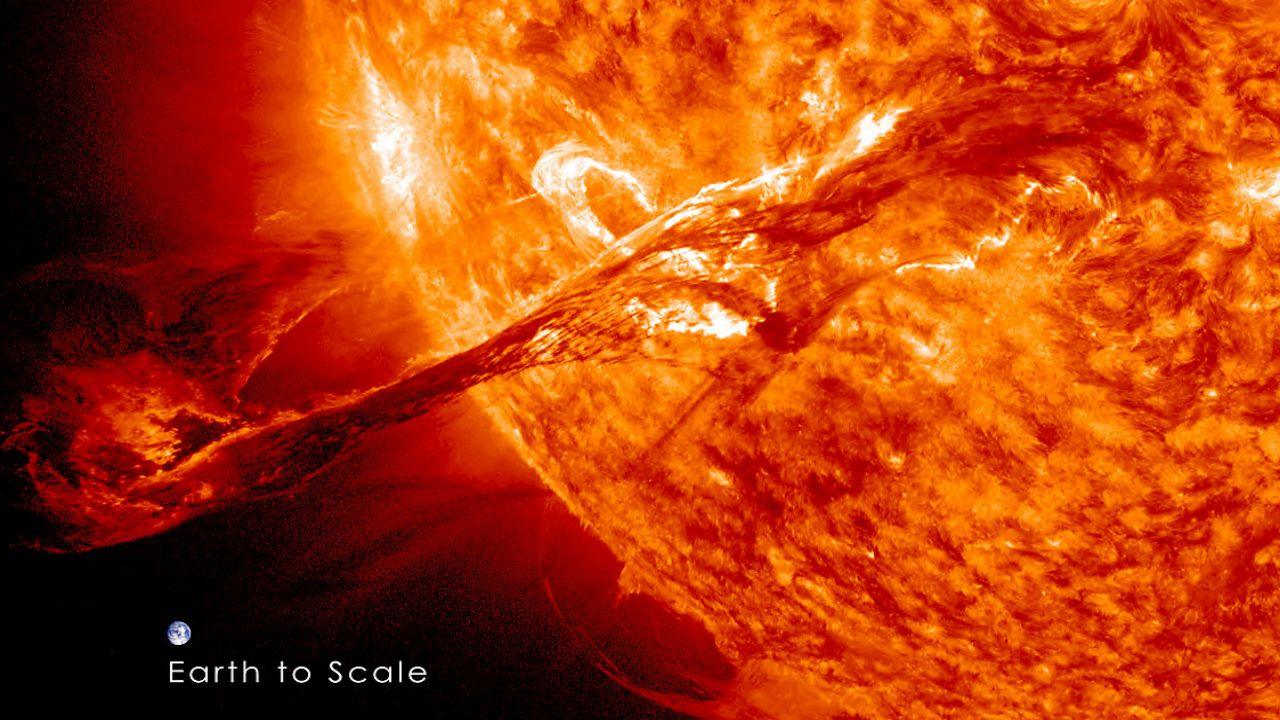

Massive Solar Flares Could Threaten Critical Infrastructure on Earth, Experts Warn

What are Solar Flares?
According to NASA, the surface of the sun is a place of magnetic turbulence. Charged gases generate electric currents that act as a magnetic dynamo inside the sun, creating magnetic fields that twist, tangle, and reorganize due to the nature of the gases. This dynamic magnetic behavior, also known as solar activity, can trigger powerful eruptions known as solar flares that release vast amounts of electromagnetic radiation, including radio waves, microwaves, X-rays, gamma rays, and visible light.
Sunspots, which are darker and cooler regions of the solar surface, are where the magnetic fields are particularly strong and are the usual source of solar flares. As a result, the number of sunspots can indicate the likelihood of a solar flare eruption.

Solar activity follows an approximately 11-year cycle with the peak of sunspot activity coinciding with solar maximum and a sunspot hiatus coinciding with the solar minimum, according to the Space Weather Prediction Center of the National Oceanic and Atmospheric Administration(opens in new tab) (NOAA). During periods of low solar activity when no sunspots are present, it is unlikely that a solar flare will occur.
The sun operates on an approximately 11-year solar cycle, but the intensity of solar maxima can vary from one cycle to another. Periods during which multiple solar cycles display higher than average activity for decades or even centuries are referred to as "grand solar maxima." While solar cycles still occur during these periods, their intensity is much greater than usual. On the other hand, when the solar maximum is lower than average for extended periods, they are referred to as "grand solar minima."
Some researchers have posited that grand solar maxima have shown some correlation with global and regional climate changes, though this hypothesis is not universally accepted. Despite the controversy, there is evidence to suggest that periods of increased solar activity can affect Earth's climate, such as by altering the planet's albedo or influencing the strength of the Earth's magnetic field.

However, predicting when a grand solar maximum or minimum will occur is challenging due to the unpredictable nature of the sun. Some scientists have suggested that we may be entering a period of grand solar minimum, which could result in a decrease in solar activity and potentially even a mini-ice age. Others argue that the current cycle is not unusual and that the sun's activity will continue as usual.
|
Event |
Start |
End |
|---|---|---|
| Homeric minimum | 950BC | 800BC |
| Oort minimum | 1040 | 1080 |
| Medieval maximum | 1100 | 1250 |
| Wolf minimum | 1280 | 1350 |
| Spörer Minimum | 1450 | 1550 |
| Maunder Minimum | 1645 | 1715 |
| Dalton Minimum | 1790 | 1820 |
| Modern Maximum | 1914 | 2008 |
| Unspecified | 2009 | present |
The Carrington Event
Solar flares can vary in size and intensity, from small flares that produce only minor disturbances to massive flares that can release as much energy as billions of nuclear bombs. The largest solar flare ever recorded, the Carrington Event of 1859, produced auroras visible as far south as the Caribbean and disrupted telegraph networks worldwide.

In September of 1859, a massive solar storm known as the Carrington Event lit up the skies with brilliant auroras and disrupted global telegraph systems, providing a glimpse into the potential destructive power of space weather. Today, scientists continue to study the Carrington Event as a cautionary tale of the potential consequences of a massive solar storm hitting our modern, technology-dependent society.
The Carrington Event was named after Richard Carrington, an astronomer who observed a significant solar flare on September 1, 1859. The flare was followed by a massive coronal mass ejection (CME) that sent a burst of charged particles hurtling towards Earth at high speeds. Two days later, the charged particles slammed into Earth's magnetic field and caused widespread geomagnetic storms, resulting in vivid auroras visible as far south as the Caribbean.
While the auroras may have been a beautiful spectacle to behold, the effects of the Carrington Event were far from benign.
Carrington Event in 2023?
If a similar event were to occur today, the consequences would be much more severe. Our modern society is heavily reliant on technology, and a massive solar storm could knock out power grids, damage satellites, and disrupt communication networks, potentially causing widespread chaos and economic damage. Scientists have estimated that a Carrington-level event could cause trillions of dollars in damage and take years to recover from.
To prepare for the potential impact of a solar storm, scientists and policymakers are working to develop more resilient infrastructure and better methods for predicting and mitigating the effects of space weather.
Additionally, companies like Amazon offer a range of products that can help protect against the effects of electromagnetic pulses (EMPs) caused by solar storms, such as Faraday cages and EMP-proof generators.
While the Carrington Event occurred over 160 years ago, its lessons continue to resonate today. As our reliance on technology grows, so too does our vulnerability to the potentially devastating effects of space weather. By heeding the lessons of the past, we can better prepare for the future and ensure that we are equipped to weather even the most severe solar storms.
Since then, several significant solar flares and coronal mass ejections (CMEs) have occurred, including a series of events in 1989 that caused a blackout in Quebec, Canada, and disrupted satellite communication and power grids in several regions. More recently, in 2012, a CME that narrowly missed Earth could have caused significant damage if it had struck our planet.
Predictions
Predictions of a future maximum's timing and strength are very difficult; predictions vary widely. There was a solar maximum in 2000. In 2006, NASA initially expected a solar maximum in 2010 or 2011, and thought that it could be the strongest since 1958.However, the solar maximum was not declared to have occurred until 2014, and even then was ranked among the weakest on record.
Experts warn that another major solar flare or CME could occur at any time, as the sun goes through a cycle of activity that lasts about 11 years on average. During this cycle, the sun's magnetic field reverses, with the north and south poles switching places, and the number and intensity of solar flares and CMEs varies.
Currently, the sun is in a period of low activity, known as a solar minimum, but it is expected to enter a more active phase in the coming years, with a peak expected in 2025. While this does not necessarily mean that a major solar flare or CME will occur, it does increase the likelihood of such an event.
To prepare for the potential effects of a solar flare or CME, experts recommend taking steps to protect critical infrastructure and personal electronics. This includes using surge protectors, backup power sources, and Faraday cages or bags to shield devices from EMPs.
Several products are available on Amazon that can help protect against EMPs and other effects of solar flares. These include surge protectors for homes and offices, solar-powered chargers and generators for backup power, and Faraday cages and bags for smartphones, tablets, and laptops.
While it is impossible to predict when or if a major solar flare or CME will occur, it is important to stay informed about the risks and take steps to protect ourselves and our technology. By doing so, we can reduce the potential impact of solar flares on our daily lives and society as a whole.
Recommended Posts
- How to Build a Bug Out Bag for Kids: Tips and Tricks
- 10 Survival Skills Every Kid Should Know
- Food prices are about to skyrocket even more; Prepare for a 'famine,' followed by housing crash, then equities wipeout - Michael Gayed
- South Threatened by Severe Weather After Texas Tornado Disaster: How to Prepare.
- The Ultimate Guide to Radiation Water Filters: How They Work






